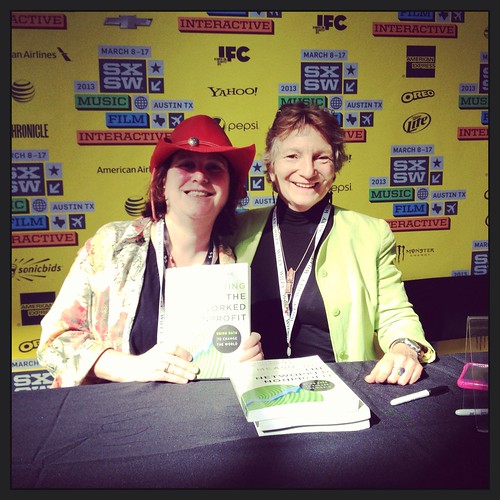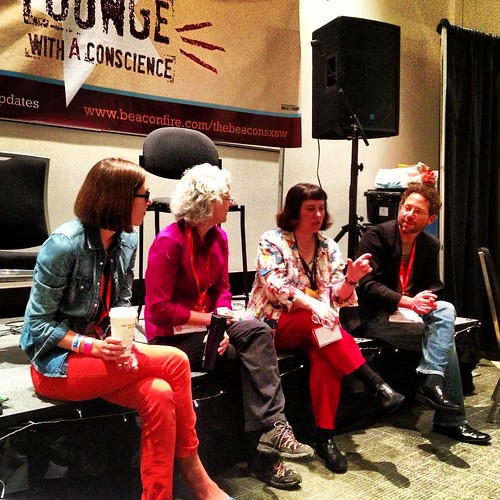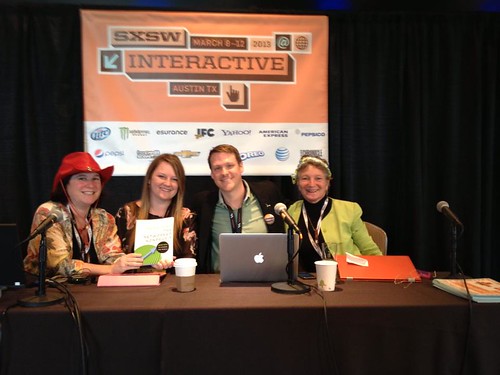
This is the last post in a series of post about my experience at SXSW. This post summarizes the sessions I facilitated or participated in related to “Measuring the Networked Nonprofit,” which included a book signing, panel discussion in the Beacon Lounge, and a workshop with co-author KD Paine.

Amy Sample Ward facilitated a lunch time conversation about impact measurement for nonprofits in the Beacon Lounge with Lynn Labieniec of Beaconfire and Robert Rosenthal of VolunteerMatch. It was a great opportunity to test out some ways to talk about performance assessment and outcomes-based approaches as David Hunter and Mario Morino. What seemed to resonate most with the crowd was the concept of “One Metric That Matters.” I had opportunity to write up a case study about how VolunteerMatch’s calculates social return on investment as a prelude for a facilitated session at Media Impact Funders, so it was a delight to hear more examples from Robert about VolunteerMatch’s measurement culture.

I had the honor of designing a two and half workshop on “Measurement” with co-author KD Paine and social media nonprofit rock stars, David Neff and Carie Lewis. KD and I took frameworks from the book – the Data-Informed Nonprofit (Crawl, Walk, Run, Fly Assessment) and 7 Steps of Measurement and then had David and Carie share how they have applied these to their organization’s measurement. We had a range of participants at different levels and a room with fixed seats or what I call “University Lecture” style. While this was a little at odds with an interactive format, we made it work.
[slideshare id=17051963&doc=combined-130308231325-phpapp01]
If you are hungry for the content, see the above deck or these two curated collections of Tweets – one from David Neff and the other from me. There were several requests for copies of the structure of our panelists spreadsheets and reports and those will be published in a separate blog post and gallery of spreadsheets. What follows below are the “ah ha” moments of insight.
1. Know What Success Is
This something that every panelist said multiple times. David Neff said that even small nonprofits can do this and recommended framework called OGST. The conversation thread made me think of this excellent blog post by my two favorite nonprofit data geeks from DoSomething. They shared the story of one of their YouTube videos getting 1.5 million views and asking was that success? Well, the purpose of the video was to get teens to donate used sports equipment. But then looked at the conversion rate for the video it was a zero! KD Paine reminded us again that we become what we measure so choose wisely.
2. Don’t Be A Zoombie Repeating the Mistakes of the Past
During the CWRF Assessment, David Neff reflected on his organization’s approach to sense-making of the data. One of the challenges they have is that while they collect data, they don’t always look at it and as a result they repeat mistakes. He pointed out that this happens with his organizations because it is a very small organization, grassroots with just a few volunteers running it. They have now made a focused effort to divide being charge of certain areas and to regularly communicate and look at their data.
#netnon I want one thing for this audience. How do we turn data into Insights?
— David J. Neff (@daveiam) March 11, 2013
3. Getting All Departments To Become Data Informed – Make It Fun
Carie Lewis shared a story about how having source codes for all their campaigns was essential to measuring all their campaigns, but it was hard to get the web team to buy into source coding. It was a change in their daily routines of publishing content: now they had to get a source code for each hyperlink they inserted. They did it for one campaign and when they saw the results, they were really excited. They felt accomplished. That was what it took to get them to accept. They created a “source jar” where if someone did the sourcing convention wrong (lazy) you had to put a quarter in the source jar. When they got enough money, they would all go out for ice cream. They haven’t gotten enough money yet!
Spend more time thinking about the data and less time collecting it #netnon #sxsw
— Brian (@BrianRobick) March 11, 2013
4. Some Ways To Visual Your Data
KD Paine shared many, many insights (check out the storify). Okay, so you have your data and you are looking at it, what are some ways to visualize it to get insights. KD says don’t use pie charts, plot your data over time. She also said that sorting and organizing your data in different ways can lead to seeing patterns. “Look across rows versus columns, for example.” She also advised us to use manual tracking for sentiment analysis because computers do not do nuance very well.
[slideshare id=17051963&doc=combined-130308231325-phpapp01]
All in all lots of good measurement for nonprofit learning.

Leave a Reply